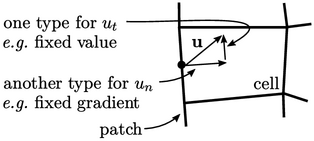4.14 Direction mixed condition
In some cases, a boundary condition is sometimes needed which applies a different underlying type — fixed value or gradient — to different components of a non-scalar field.

The condition is most readily applied to
velocity  , where different conditions are applied to its normal and
tangential components to the patch,
, where different conditions are applied to its normal and
tangential components to the patch,  and
and  respectively.
respectively.
The direction mixed condition combines the mixed condition from Sec. 4.9 with the transform conditions of Sec. 4.11 . The mixed condition can be first expressed in the form of a general transform condition Eq. (4.13 ) as
 |
(4.22) |
 is replaced by a
transformation tensor
is replaced by a
transformation tensor  , whose components are value fractions in the
range 0 to 1, by
, whose components are value fractions in the
range 0 to 1, by
![rn b f = G(Y; b)+ G [I Y] ; ------+ P : C \relax \special {t4ht=](img/index1887x.png) |
(4.23) |
 is set according to the requirements of the
boundary condition which is derived from this direction mixed
framework.
is set according to the requirements of the
boundary condition which is derived from this direction mixed
framework.

Imagine an example of  at a face oriented
with normal vector
at a face oriented
with normal vector  , for which the
, for which the  condition is fixed
gradient and
condition is fixed
gradient and  is fixed value. The value fraction must be 1 in the
tangential direction and 0 in the normal direction, which
gives:
is fixed value. The value fraction must be 1 in the
tangential direction and 0 in the normal direction, which
gives:
 |
(4.24) |
 is the calculated
is the calculated
 using current
using current  by Eq. (4.23
) and the explicit
gradient
by Eq. (4.23
) and the explicit
gradient  is calculated from Eq. (4.17
).
is calculated from Eq. (4.17
).
The factor  corresponds to
corresponds to
 .
For a vector field, it is calculated, as in the symmetry condition
in Eq. (4.19
), by
.
For a vector field, it is calculated, as in the symmetry condition
in Eq. (4.19
), by
 |
(4.25) |
 , the factor is
, the factor is  , where
, where  are the coeffcients
for a vector, as described for the symmetry condition in
Sec. 4.12
.
are the coeffcients
for a vector, as described for the symmetry condition in
Sec. 4.12
.
The condition is implemented using value and
gradient factors according to the transform condition, summarised
in the table on page 284
. Any boundary condition
which is based on this direction mixed condition then only requires
a description of the  ,
,  and
and  parameters.
parameters.

